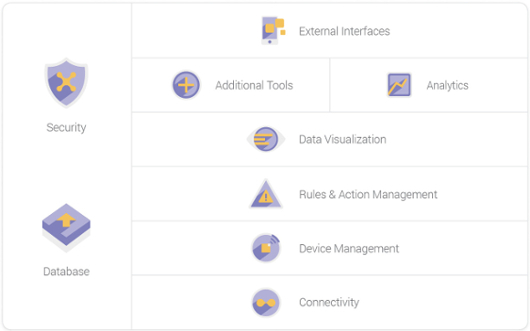Many companies we talk to are still still confused about what is an IoT platform, and when and why they need one. So today we’re going back to the basics with our definition of IoT platform. We’ll also cover the various reasons you should use a pre-built platform for your IoT business, you can read on and see if they’re applicable to you.
What is an IoT platform?IoT platforms are enablers for business digitalization:
- They connect and manage sensors and devices throughout their lifecycle.
- They allow you to rapidly develop useful applications based on your new data streams
- They are extensible to make the applications available for users on any device and interface with external systems
There are a number of components an IoT platform needs to have in order to perform these functions well:
- Connectivity for any device or sensor you need, now or in the future.
- Device management for the entire lifecycle.
- Rules and actions, because you want to take automatic actions based on the data you are collecting.
- Data visualization and analytics sliced and diced in different ways for different users.
- External connectivity to applications and 3rd party software.
- Built-in security at every level of the application.
- Data storage and optimization to have the data available when needed.

When do you need an IoT platform?While we described the basic components of an IoT platform, there is much more that goes into building a platform that can scale and grow with your needs. Here are a number of factors that IoT solution providers need to take into consideration:
FlexibilityA flexible platform can always incorporate new technologies fast.
Let’s look at IoT standards and protocols, for example. If you build or choose a platform that only supports the standards you are currently using, your IoT applications will be severely limited in how they can grow. New standards and protocols are introduced all the time and you’re going to need to support them if you want to include the latest, greatest and most cost-effective sensors.
Your business needs may also change, and your platform should be flexible enough to meet any unexpected future demands.
How will you build flexibility into your IoT business?
Speed to MarketA faster time to market means fewer expenses and a stronger competitive positioning. Can a platform get you to market faster than the alternatives? Without compromising on flexibility and scalability?
Cloud ComputingDeploying an IoT application relies on deep expertise in cloud computing. We regularly deploy on premise, private clouds and public clouds with the varying security and performance requirements.
PerformancePerformance, even peak hours should be high. A security company running a connected business alarm application has to be able to deal with an event peak load at 10 PM, when most employees arm their alarms. At 11 PM no one is arming their alarm and the system needs to scale back down.
Part of maintaining high performance consistently is also having a high availability and disaster recovery plan in place.
ScalabilityMany of our customers scale their IoT business quite fast. Order of magnitude changes in devices supported, notifications from devices, customers and more are quite routine. Platforms are generally quite good at scaling seamlessly.
SecuritySecurity is an important topic that warrants consideration separately. How you treat your sensitive information in every layer of your platform is critical. There is much regulation around security and privacy. For example, each of your customers is going to have a different retention policy, which means you’ll have to store their information for different lengths of time. They’ll also have different data access policies of the information.
How to choose an IoT platformWe hope this is helpful in understand what goes into the making of an IoT platform. It’s pretty clear that choosing an IoT platform will let anyone – starting with the digital enterprise through system integrators and service providers – focus on their core business, while letting the platform provider worry about putting the right infrastructure in place.
To help you choose the right platform, we’ve put together the IoT Platform Comparison. This is a feature by feature comparison of all the platform types and it will help you choose the best fit for your business.

